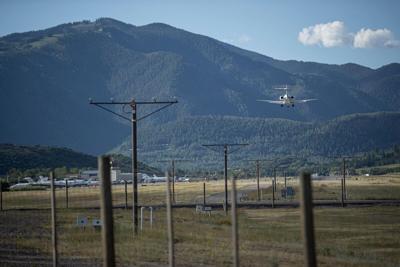Close review of the ASE Vision Committee’s plan continued Wednesday, with the Pitkin Board of County Commissioners sifting through the first 11 goals of the guiding document — mostly in agreement, but leaving the meatier issues for next week when they can start fresh on items that to date have seen the most divergence of opinion.
After the BOCC was unable to advance in its revision of Goal No. 12 — to “reconfigure the airfield to accommodate Aircraft Design Group III aircraft with wingspans greater than 95 feet” — and nearing the three-hour mark of this portion of its special work session, the brakes were slammed on the discussion. Rather, it will be continued Tuesday at 10 a.m.
“We were getting hung up on a lot of stuff,” Commissioner Patti Clapper said Thursday. “We decided, ‘Let’s start fresh next Tuesday’ so we don’t have a long day before and a long day afterward.”
Included within the 15 specific recommendations are maximizing Aspen-Pitkin County Airport’s safety and sustainability and improving air service reliability. There are more than 70 sub-recommendations to the mainstays of the “Final Report of the Airport Vision Committee — The Common Ground Recommendations,” Pitkin County Manager Jon Peacock noted.
A section on the BOCC’s airport project updates may be found at pitkincounty.com.
On Tuesday the commissioners will pick up where they left off in further discussing the much-discussed Goal No. 12.
Elected officials weren’t able to move past how to introduce language into the stated goal about future technology that could be cleaner and more energy efficient without finding it either too binding or not specific enough.
“What’s the community going to perceive it to say? The airline industry? How much do we want to say, and what is it going to tie us into?” Clapper said Thursday.
The language is important, she implied, because it would be tied to a goal that could in turn create the potential ramifications of an airport able to accept a fleet in ADG III, with wingspans as wide as 118 feet.
Peacock cautioned that assurances about future designs are nonexistent.
“Some airlines may not be there [with their fleet mix]. I think the goal is to understand those implications and understand what that mix is.”
To get to an ADG III level and meet federal standards for runway and taxiway separation, moving the runway or moving the taxiway closer to the terminal will be required. Last month, the majority of the BOCC voted in favor of Goal No. 13 (which ostensibly will be discussed Tuesday): to “leave the runway where it is.”
BOCC Vice Chair Kelly McNicholas Kury reflected on the conundrum of the status quo, which doesn’t allow for options such as cleaner planes, she said.
Clapper, on Thursday, spoke of the challenges the board faces in rendering a decision on both the air side and the land side “when the industry doesn’t know where it’s going.” The life of the workhorse CRJ-700 seems likely to be extended, due to demand and the state of the industry as they’re related to the pandemic. But the promises of cleaner, quieter future aircraft remain elusive for the time being. Opening the door to the unknown, both on the commercial and general aviation sides, which an ADG III designation could allow, remains a concern for the BOCC.
Commissioner Greg Poschman asked, given the number of unknowns, why the BOCC seemed to be pushing toward putting a bow on the vision document.
“We’re not there yet,” Poschman said.
McNicholas Kury said that one reason is, given the time that outgoing Commissioner George Newman has spent working on airport issues and his knowledge of the subjects, the decision would be well-served for completion during his tenure.
The 15 recommendations about the airport’s future have been under review by the BOCC since August, though the white paper was the product of more than 120 members of an appointed citizen committee that worked for nearly 18 months to produce it. In the end, 63 people who were originally involved with the committees voted on the recommendations.


